You’ve probably noticed your water bill climbing each summer as you try to keep your garden looking fresh and vibrant. Don’t worry – you won’t need to sacrifice beautiful blooms to conserve water. From the sun-loving Painted Daisy to the hardy Purple Coneflower, there’s a stunning variety of drought-resistant flowers that’ll flourish with minimal irrigation. Let’s explore these water-wise options that’ll transform your yard into a low-maintenance oasis.
Contents
- 1 1. Painted Daisy
- 2 2. Purple Coneflower
- 3 3. Desert Marigold
- 4 4. California Bluebell
- 5 5. Blanket Flower
- 6 6. Black-eyed Susan
- 7 7. Red Sunflower
- 8 8. Mexican Sage
- 9 9. Desert Lily
- 10 10. Torch Cactus
- 11 11. Autumn Sage
- 12 12. Evening Primrose
- 13 13. Yellow Bells
- 14 14. New Mexico Penstemon
- 15 15. Texas Lantana
1. Painted Daisy
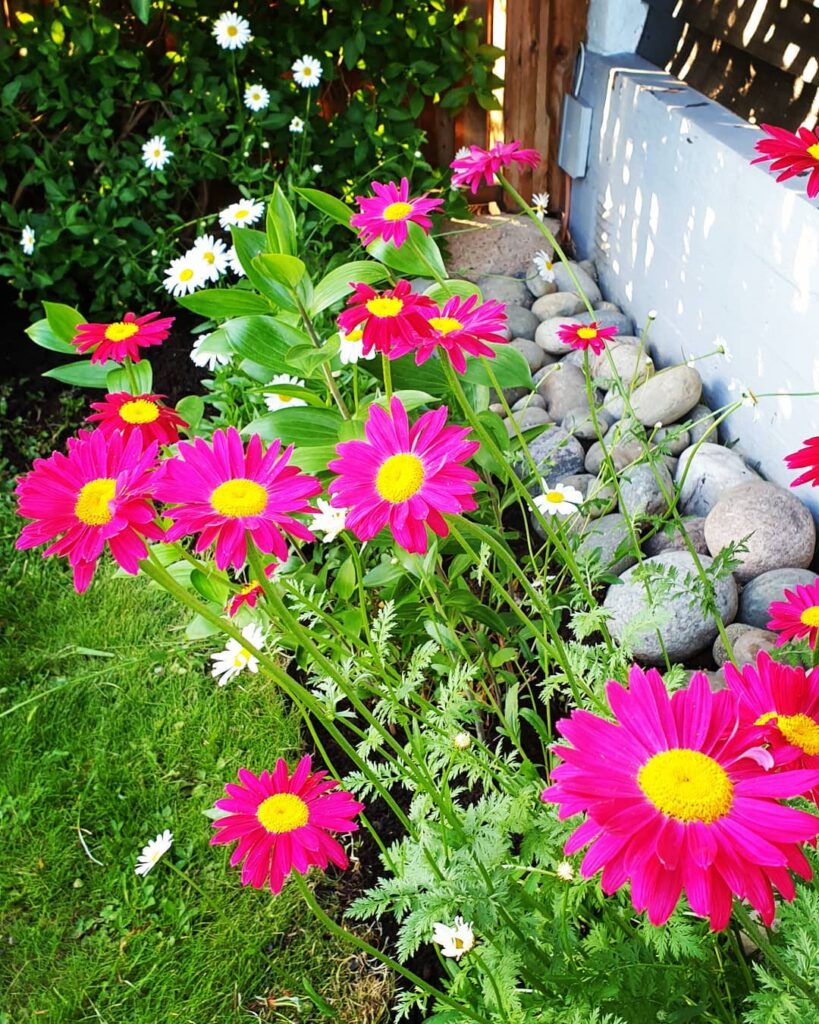
The Painted Daisy (Tanacetum coccineum) is a vibrant, drought-tolerant perennial that produces daisy-like blooms in shades of pink, red, and white with yellow centers. These cheerful flowers bloom in late spring through early summer, reaching heights of 18-36 inches. Their fernlike foliage adds texture to gardens, and the flowers make excellent cutting specimens. Despite their delicate appearance, Painted Daisies are relatively low-maintenance and can withstand periods of reduced water once established.
- Light: Full sun to partial shade; best blooming occurs in full sun
- Water: Moderate to low water needs; water deeply but infrequently once established
- Soil: Well-draining, fertile soil with neutral to slightly alkaline pH
- Temperature: Hardy in zones 3-7
- Spacing: Plant 12-18 inches apart
- Maintenance: Deadhead spent blooms to encourage additional flowering
- Fertilizer: Light feeding in spring with balanced fertilizer
- Drainage: Requires good drainage; cannot tolerate wet feet
2. Purple Coneflower
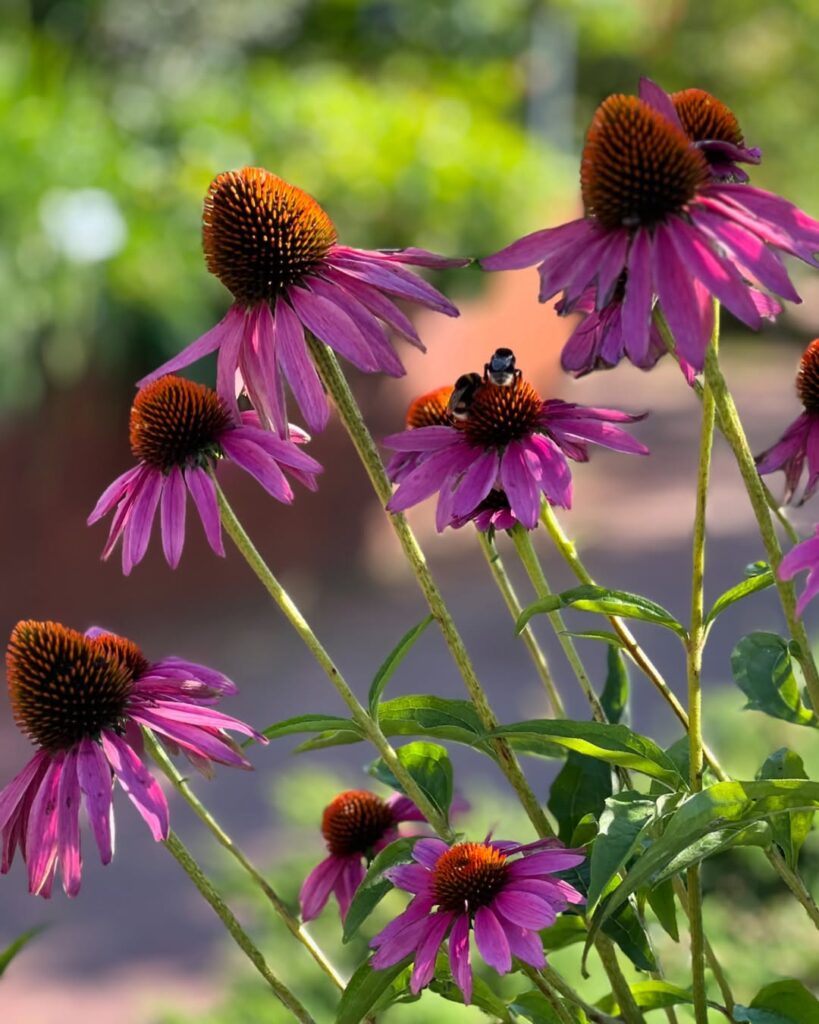
Purple Coneflower (Echinacea purpurea) is a striking drought-tolerant perennial that produces large daisy-like blooms with distinctive cone-shaped centers. The flowers feature drooping purple-pink petals surrounding a spiky copper-orange center cone, blooming from summer through fall. Beyond its ornamental value, this native North American plant attracts pollinators like butterflies and bees, while also being deer-resistant and useful in traditional herbal medicine.
- Light: Full sun to partial shade; best flowering occurs in full sun
- Water: Low to moderate; drought-tolerant once established; water deeply but infrequently
- Soil: Well-draining, average to lean soil; tolerates clay and rocky conditions
- pH: 6.0-7.0
- Temperature: Hardy in zones 3-9
- Spacing: 18-24 inches apart
- Height: 2-4 feet tall
- Maintenance: Deadhead spent blooms to encourage more flowers; divide every 3-4 years
3. Desert Marigold
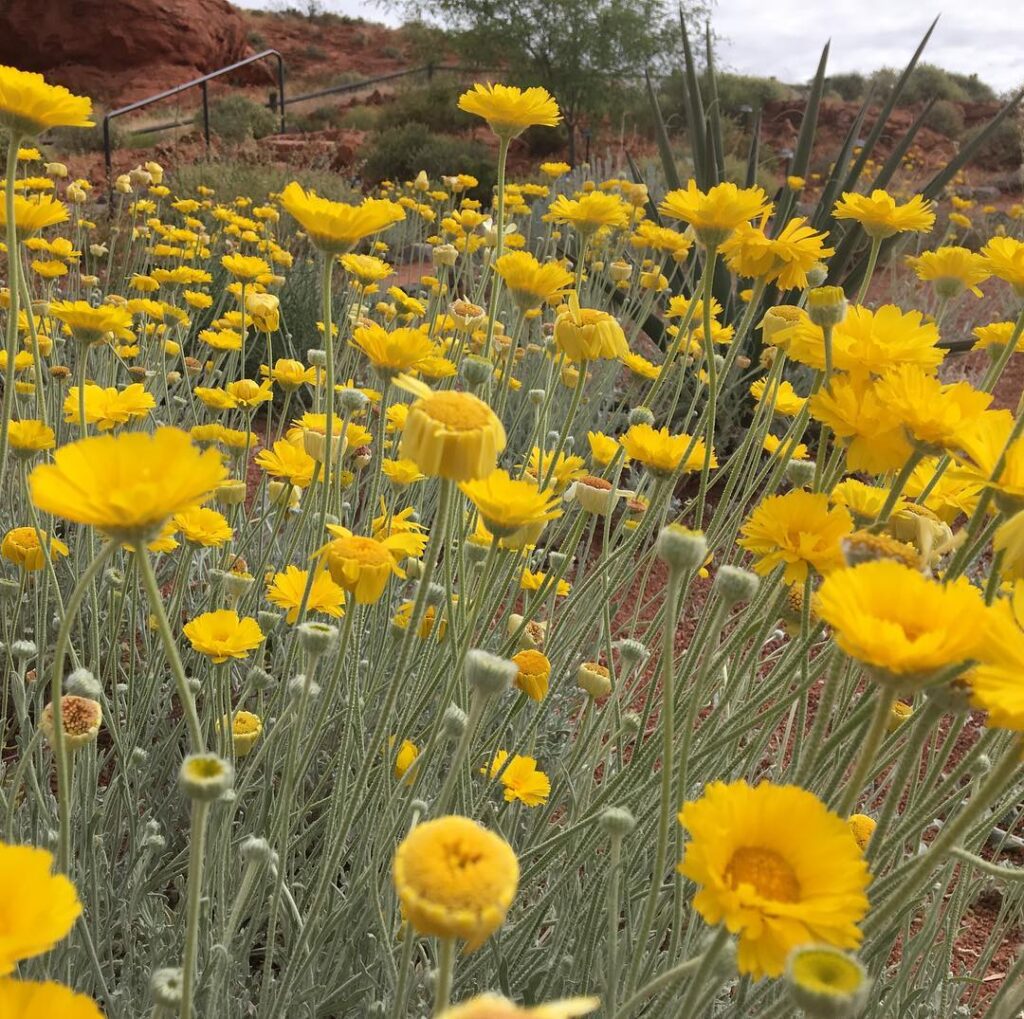
Desert Marigold (Baileya multiradiata) is a drought-tolerant flowering plant native to the southwestern United States and Mexico. This perennial wildflower produces bright yellow, daisy-like blooms that stand atop silvery-gray stems and foliage. Growing 1-2 feet tall, Desert Marigold blooms from spring through fall, providing long-lasting color in arid landscapes. The plant’s woolly leaves and stems help conserve water, making it exceptionally suitable for water-wise gardens.
- Light: Full sun exposure
- Water: Very low water needs; drought-tolerant once established
- Soil: Well-draining, sandy or rocky soil
- Temperature: Heat tolerant; hardy in USDA zones 8-10
- Spacing: 12-18 inches between plants
- pH: Tolerates slightly acidic to alkaline soil (6.0-8.0)
- Maintenance: Low maintenance; deadhead spent blooms to encourage more flowers
- Drainage: Requires excellent drainage; cannot tolerate wet feet
4. California Bluebell
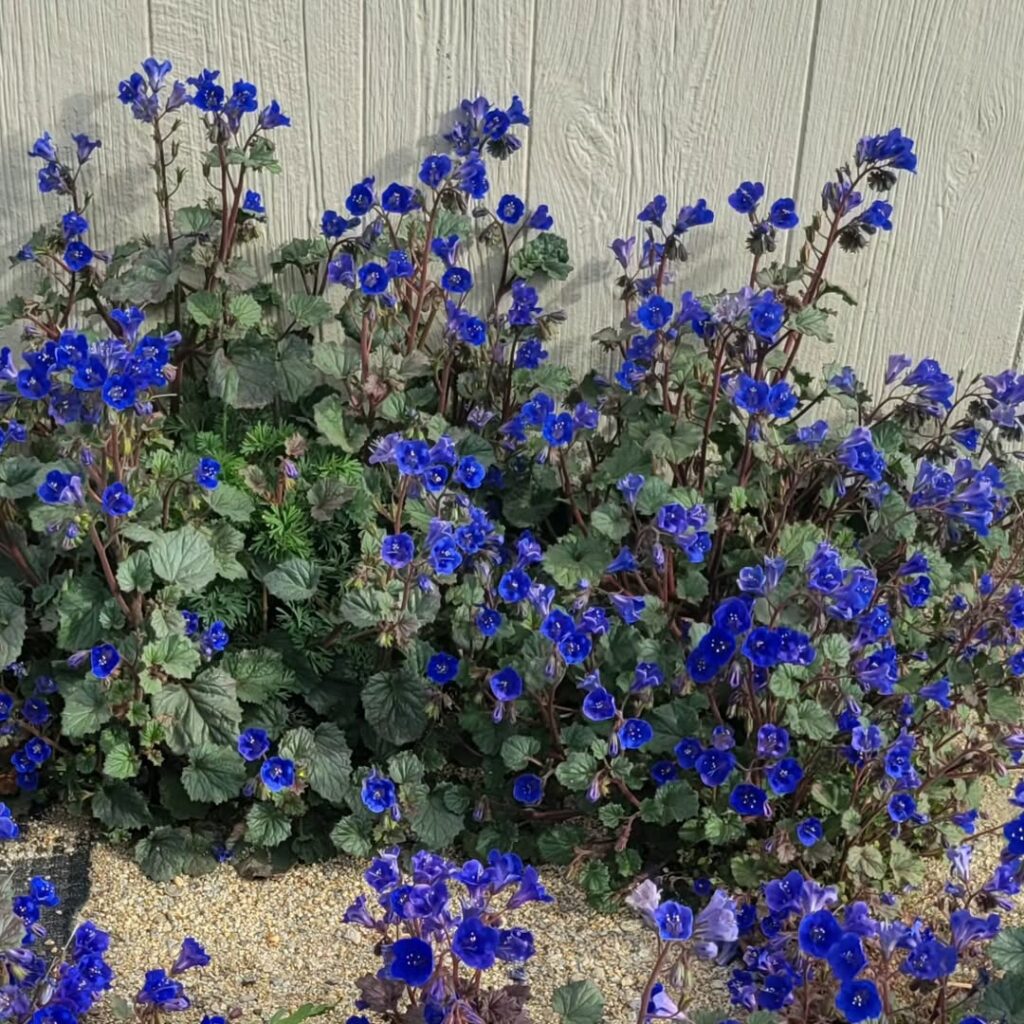
California Bluebell (Phacelia campanularia) is a drought-tolerant annual wildflower native to California’s desert regions. This low-growing plant produces vibrant blue, bell-shaped blooms with distinctive white throats and prominent stamens. Growing 6-12 inches tall, it creates dense clusters of flowers that attract pollinators, especially bees and butterflies, making it an excellent choice for water-wise gardens and natural landscaping.
- Light: Full sun
- Water: Low water needs; drought-tolerant once established
- Soil: Well-draining, sandy or rocky soil
- Temperature: Hardy in zones 2-11
- Bloom Time: Spring to early summer
- Spacing: 6-8 inches apart
- pH: 6.0-8.0
- Maintenance: Low; self-seeding
5. Blanket Flower

Blanket Flower (Gaillardia) is a cheerful, daisy-like perennial that produces vibrant blooms in shades of red, yellow, and orange from early summer through fall. Named for its tendency to create a blanket-like spread of flowers, this drought-tolerant plant is native to North and South America. Its long-lasting blooms attract pollinators like butterflies and bees, while its sturdy stems make it excellent for cut flowers. Blanket Flowers are low-maintenance and can thrive in challenging conditions, making them perfect for water-conscious gardens.
- Light: Full sun; at least 6-8 hours of direct sunlight daily
- Water: Low to moderate; drought-tolerant once established
- Soil: Well-draining, sandy or average soil
- pH: 6.1-6.8
- Hardiness Zones: 3-10
- Spacing: 12-18 inches apart
- Height: 12-24 inches tall
- Temperature: Tolerates heat well
- Fertilizer: Light feeding; too much nitrogen reduces blooming
6. Black-eyed Susan
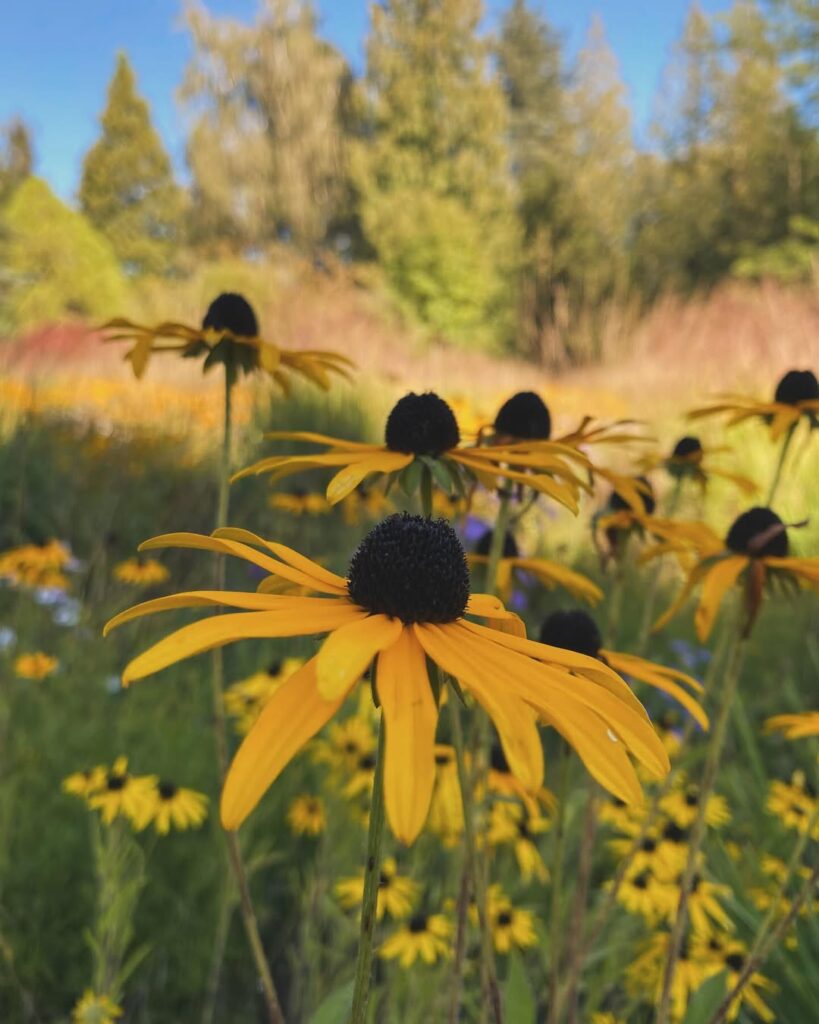
Black-eyed Susan (Rudbeckia hirta) is a cheerful, drought-tolerant perennial wildflower known for its bright yellow-orange petals surrounding dark brown center cones. Growing up to 3 feet tall, these hardy plants bloom from summer through fall, attracting pollinators like butterflies and bees. Their low-maintenance nature and ability to naturalize make them excellent choices for water-conscious gardeners looking to add long-lasting color to their landscapes.
- Light: Full sun to partial shade, with best blooming in full sun
- Water: Moderate when establishing, drought-tolerant once established; water deeply but infrequently
- Soil: Well-draining, average to poor soil; tolerates clay
- pH: 6.0 to 7.0
- Temperature: Hardy in USDA zones 3-9
- Spacing: 18-24 inches apart
- Fertilizer: Light feeder; no regular fertilization needed
- Maintenance: Deadhead spent blooms to encourage more flowers; divide every 3-4 years
7. Red Sunflower
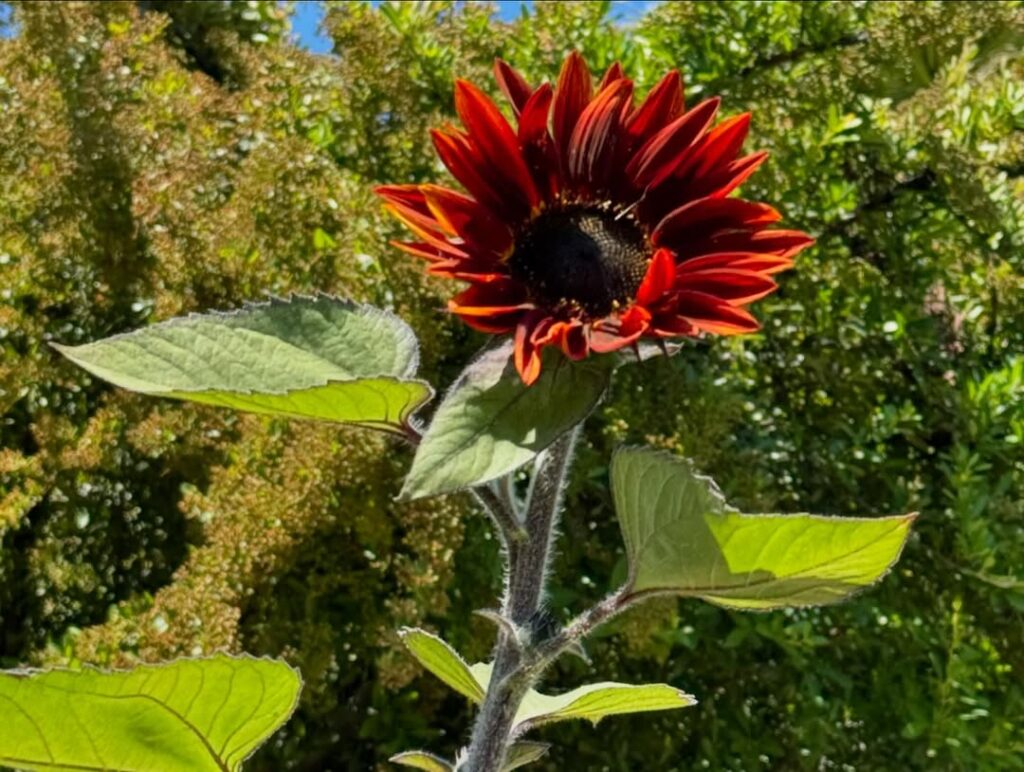
The drought-tolerant Red Sunflower is a striking variety that produces deep crimson blooms atop sturdy stalks reaching 4-6 feet in height. These heat-loving annuals feature dark centers surrounded by rich burgundy to red petals, making them excellent statement plants in water-wise gardens and dry landscapes. Unlike traditional sunflowers that may require frequent watering, this variety has adapted to thrive with minimal moisture while still delivering the same dramatic impact and attracting pollinators throughout the blooming season.
- Light: Full sun, minimum 6-8 hours daily
- Water: Low to moderate; water deeply but infrequently once established
- Soil: Well-draining, sandy or loamy soil
- pH: 6.0-7.5
- Temperature: Thrives in warm conditions, 70-80°F (21-27°C)
- Spacing: 6 inches between plants
- Planting Time: Spring, after last frost
- Hardiness Zones: Annual in most zones, best in zones 2-11
8. Mexican Sage

Mexican Sage (Salvia leucantha) is a striking drought-resistant perennial that produces velvety purple flower spikes with white blooms from late summer through fall. This hardy plant grows in dense, silvery-green foliage clumps reaching 3-4 feet tall and wide, making it an excellent choice for water-conscious gardens. Its aromatic leaves and long-lasting blooms attract pollinators like butterflies and hummingbirds while naturally repelling deer and rabbits.
- Light: Full sun to partial shade
- Water: Low to moderate; water deeply but infrequently once established
- Soil: Well-draining, sandy or loamy soil
- Temperature: Hardy in zones 8-10
- Spacing: 3-4 feet apart
- pH: Tolerates 6.0-8.0
- Fertilizer: Light feeding in spring; drought-tolerant plants need minimal fertilization
- Drainage: Excellent drainage required; cannot tolerate wet feet
- Maintenance: Prune back hard in late winter to encourage new growth
9. Desert Lily
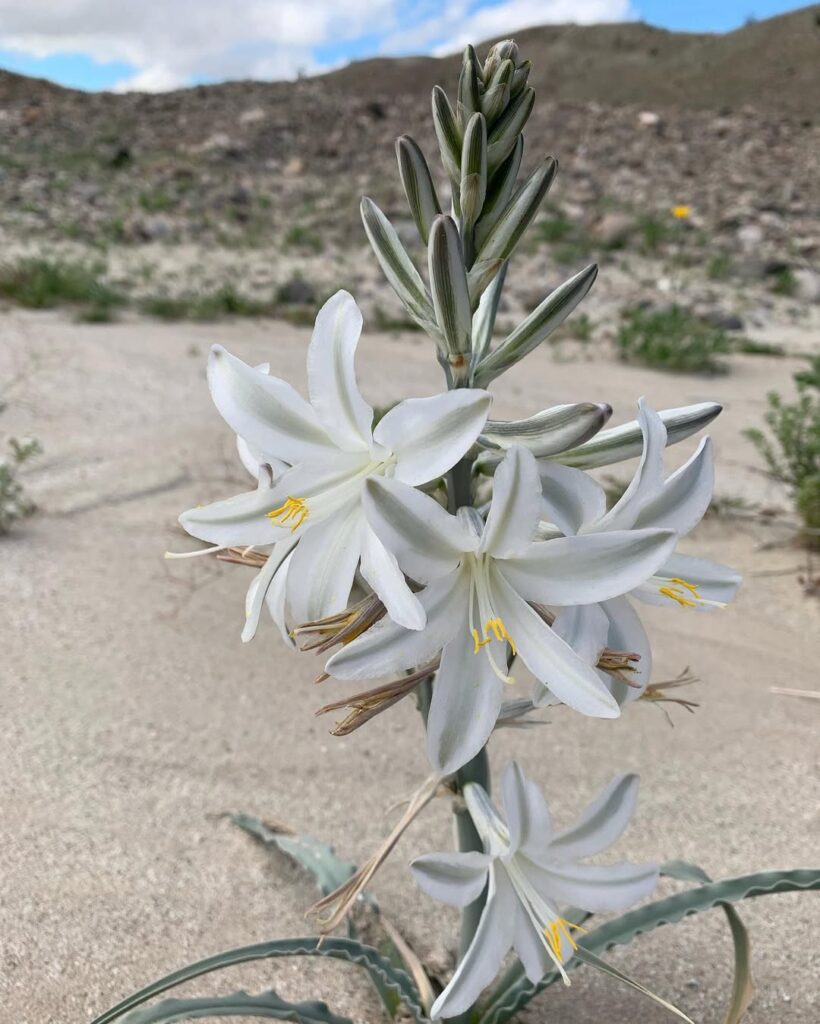
The Desert Lily (Hesperocallis undulata) is a rare and striking flowering plant native to the Southwestern United States and Northern Mexico. This drought-resistant perennial produces elegant white, trumpet-shaped blooms atop tall stems that emerge from underground bulbs. The flowers emit a subtle fragrance and typically bloom in spring after winter rains, making them a unique addition to water-wise gardens. Their long, wavy leaves grow in a basal rosette pattern, and the plant goes dormant during extreme heat.
- Light: Full sun to partial shade
- Water: Minimal; relies mainly on natural rainfall; water sparingly during growing season
- Soil: Well-draining sandy or gravelly soil
- Temperature: Heat tolerant; hardy in zones 8-10
- Planting Depth: Bulbs should be planted 4-6 inches deep
- Spacing: 12-18 inches between plants
- Special Needs: Requires excellent drainage and winter chill period for blooming
10. Torch Cactus
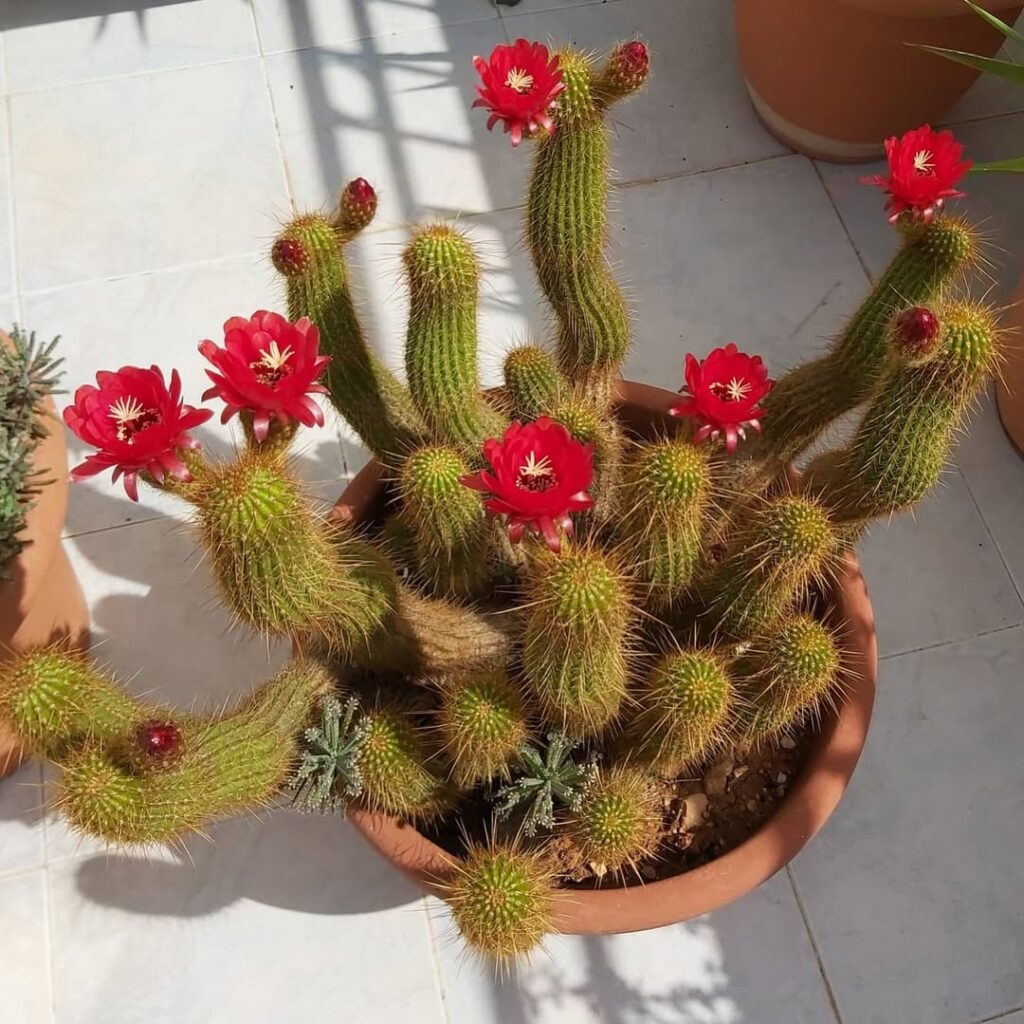
The Torch Cactus (Echinopsis huascha) produces vibrant, trumpet-shaped blooms in shades of red, orange, or pink that emerge from a columnar cactus. These spectacular flowers typically bloom at night or early morning and can reach up to 3 inches in length, creating a striking display against the green, spiny stems. Though individual blooms may only last for a day or two, the cactus can produce multiple flowers throughout its blooming season, typically in spring and summer.
- Light: Full sun to partial shade; best flowering occurs with 6+ hours of direct sunlight daily
- Water: Minimal; water thoroughly when soil is completely dry, reduce watering in winter
- Soil: Well-draining cactus mix or sandy soil with added perlite or pumice
- Temperature: Hardy in zones 9-11; prefers temperatures between 70-80°F (21-27°C)
- Humidity: Low humidity preferred; tolerates average household humidity
- Fertilizer: Light feeding with cactus fertilizer during growing season
- Container: Clay or terracotta pot with drainage holes
11. Autumn Sage
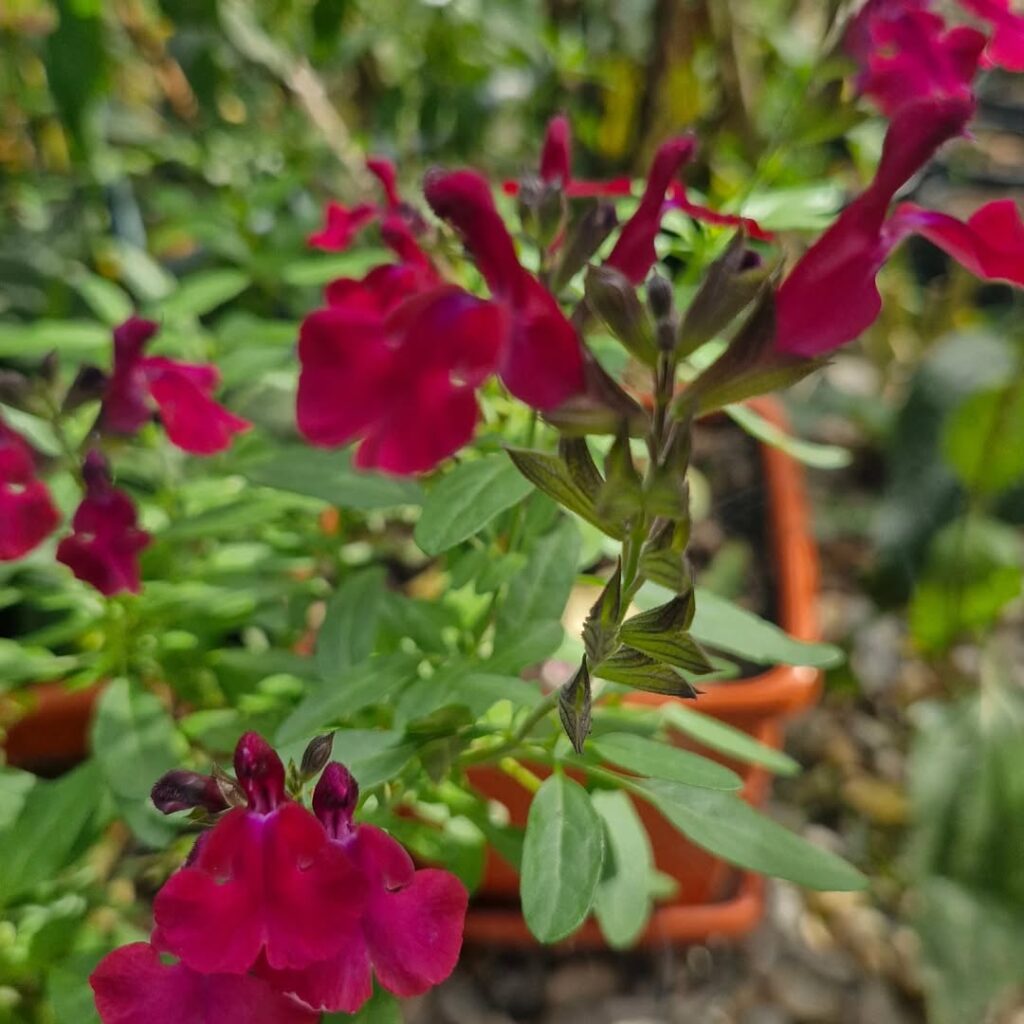
Autumn Sage (Salvia greggii) is a drought-tolerant perennial shrub known for its vibrant red tubular flowers that bloom from spring through fall. This hardy plant, native to Texas and Mexico, typically grows 2-3 feet tall and wide, making it perfect for borders, rock gardens, and xeriscaping. Its aromatic foliage and long-lasting blooms attract hummingbirds and butterflies while being naturally deer-resistant.
- Light: Full sun to partial shade; best flowering occurs in full sun
- Water: Low water needs once established; water deeply but infrequently
- Soil: Well-draining, neutral to slightly alkaline soil
- Hardiness: USDA zones 7-10
- Spacing: 24-36 inches apart
- Maintenance: Prune lightly in early spring to maintain shape
- Fertilizer: Light fertilization in spring; thrives in lean soil conditions
12. Evening Primrose
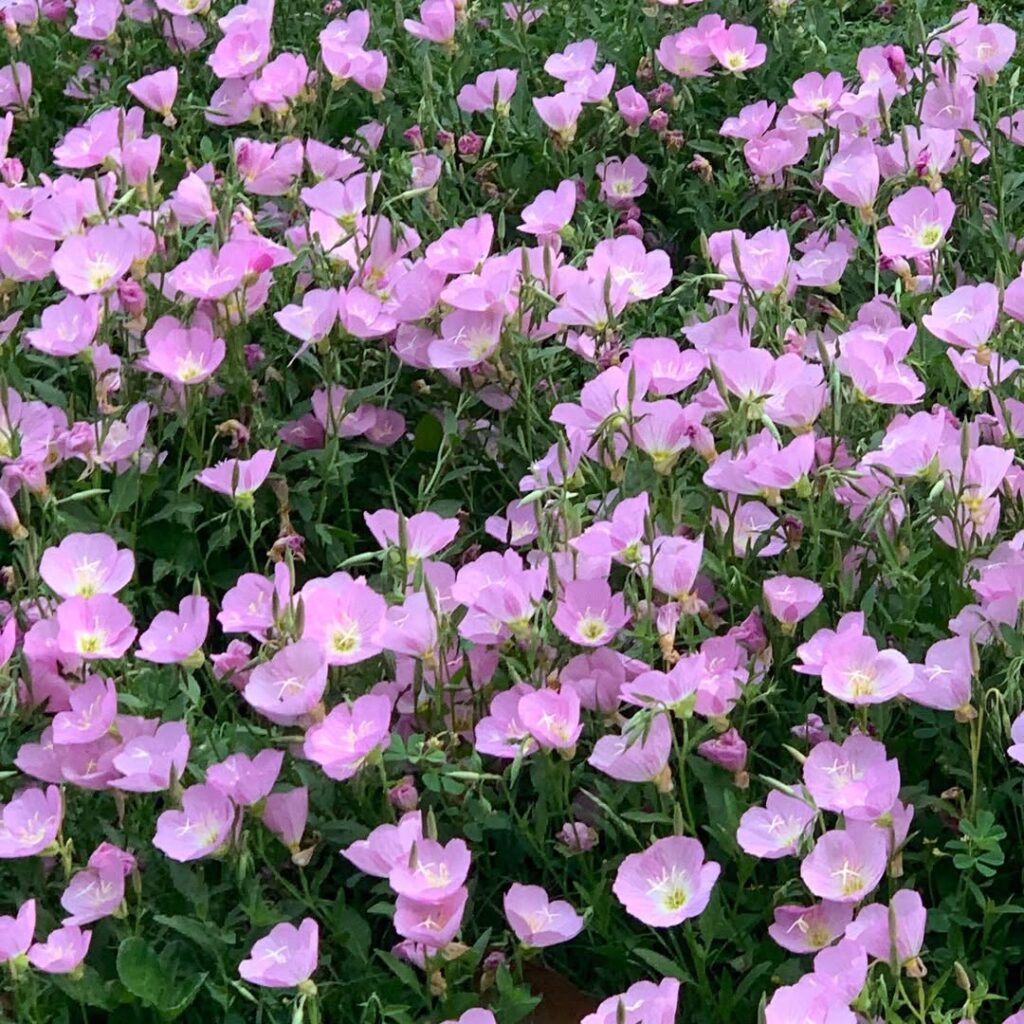
Evening Primrose is a drought-tolerant wildflower native to arid regions of North America, known for its large, fragrant white blooms that open in the evening and close by morning. This low-maintenance perennial grows in spreading mounds of narrow gray-green leaves, reaching heights of 6-12 inches. The flowers attract night-pollinating moths and provide seasonal interest from spring through summer, while requiring minimal water once established.
- Light: Full sun to partial shade
- Water: Low; drought-tolerant once established; water deeply but infrequently
- Soil: Well-draining, sandy or gravelly soil; tolerates poor soil conditions
- Temperature: Heat-tolerant; hardy in USDA zones 4-9
- Spacing: 12-18 inches apart
- Maintenance: Minimal pruning needed; remove spent blooms to encourage flowering
- Growth Rate: Moderate to fast
- Special Notes: Avoid overwatering; excellent for rock gardens and xeriscaping
13. Yellow Bells
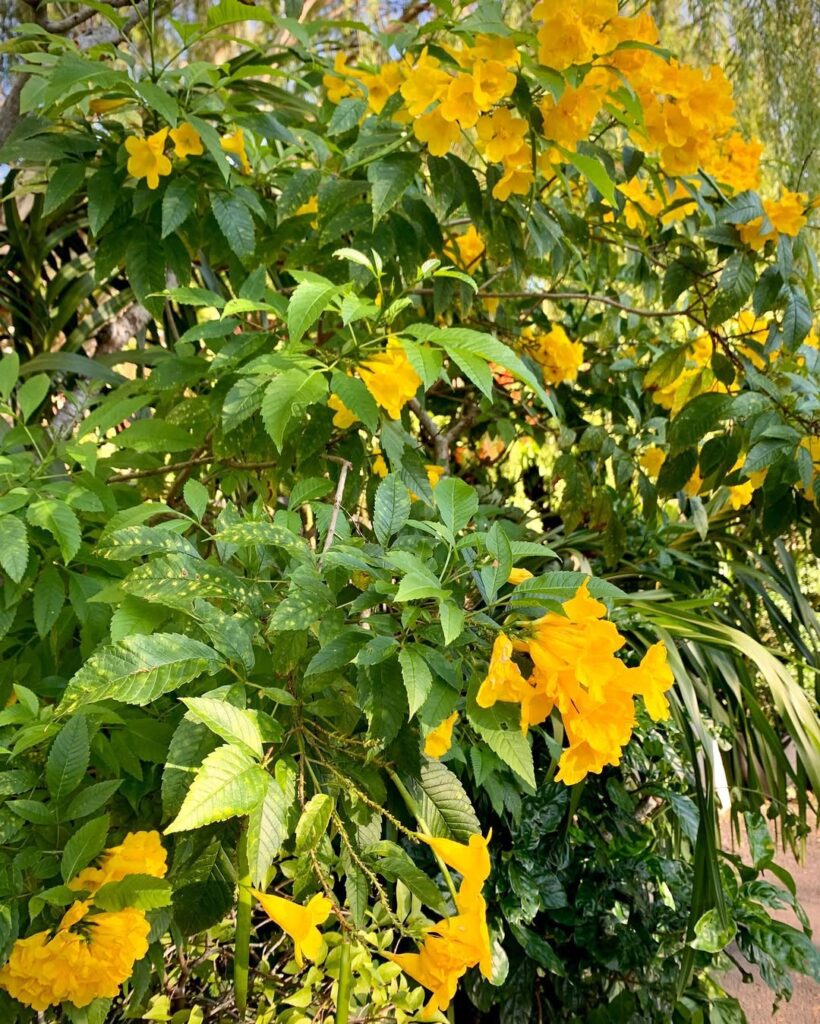
Yellow Bells (Tecoma stans) is a drought-tolerant flowering shrub native to the southwestern United States and Mexico. This fast-growing plant produces clusters of bright yellow, trumpet-shaped blooms that attract hummingbirds and butterflies throughout the warm season. Growing up to 15 feet tall, it features dark green compound leaves and can be pruned to maintain a smaller, more compact shape. The plant is particularly valued for its long blooming period and ability to thrive in hot, arid conditions with minimal maintenance.
- Light: Full sun; at least 6 hours of direct sunlight daily
- Water: Low water needs once established; water deeply but infrequently
- Soil: Well-draining soil; tolerates poor soil conditions
- Temperature: Hardy in USDA zones 8-11
- Fertilizer: Light feeding in spring; tolerates low-nutrient conditions
- Spacing: Plant 4-6 feet apart
- Maintenance: Prune in late winter or early spring to maintain shape
14. New Mexico Penstemon
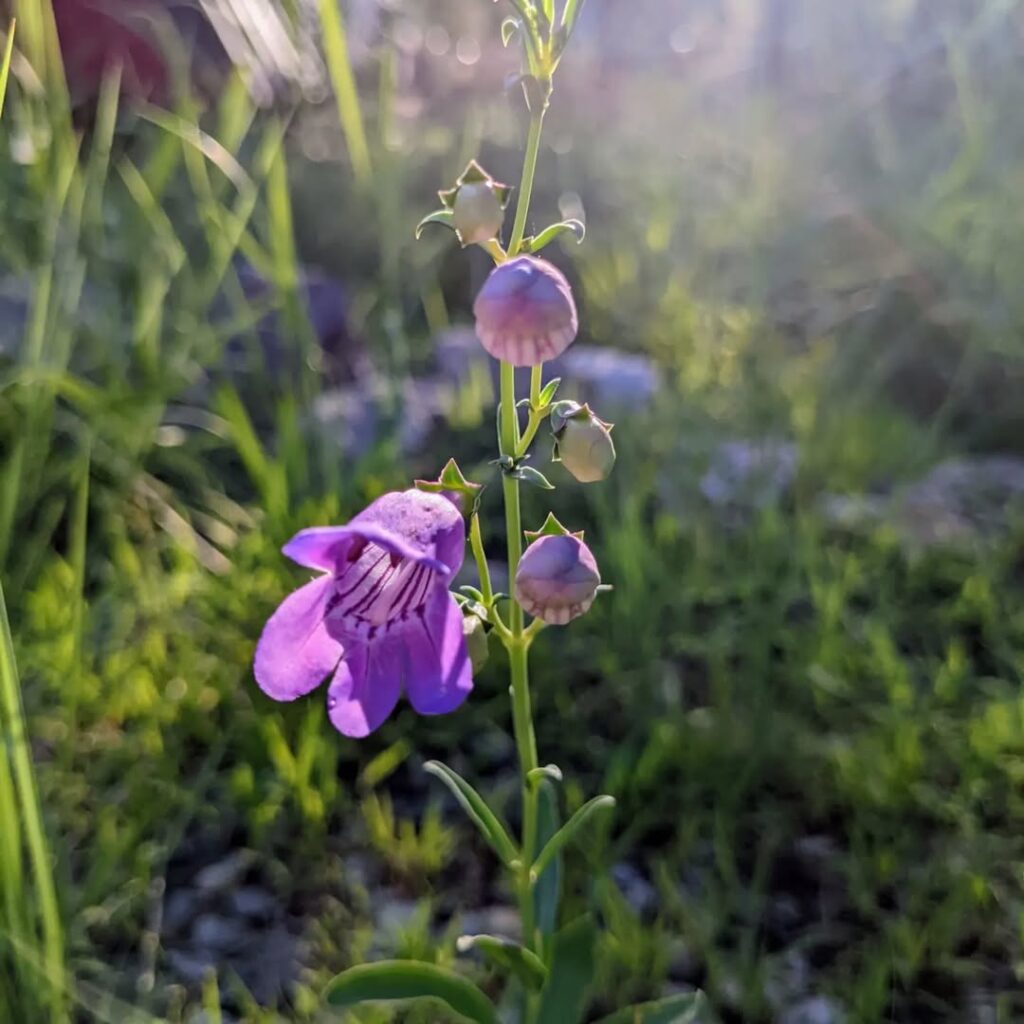
New Mexico Penstemon (Penstemon neomexicanus) is a striking perennial wildflower native to the southwestern United States, particularly New Mexico. This drought-tolerant plant produces tall spikes of tubular purple-blue flowers that bloom from late spring through summer, attracting hummingbirds and pollinators. Growing up to 2 feet tall, its narrow green leaves remain evergreen in mild winters, making it an excellent choice for water-wise gardens and xeriscaping.
- Light: Full sun to partial shade
- Water: Low; drought-tolerant once established
- Soil: Well-draining, sandy or rocky soil
- pH: 6.0-8.0
- USDA Hardiness Zones: 4-9
- Spacing: 12-18 inches apart
- Height: 18-24 inches
- Bloom Time: Late spring to summer
- Maintenance: Low; trim spent flower stalks to encourage reblooming
15. Texas Lantana
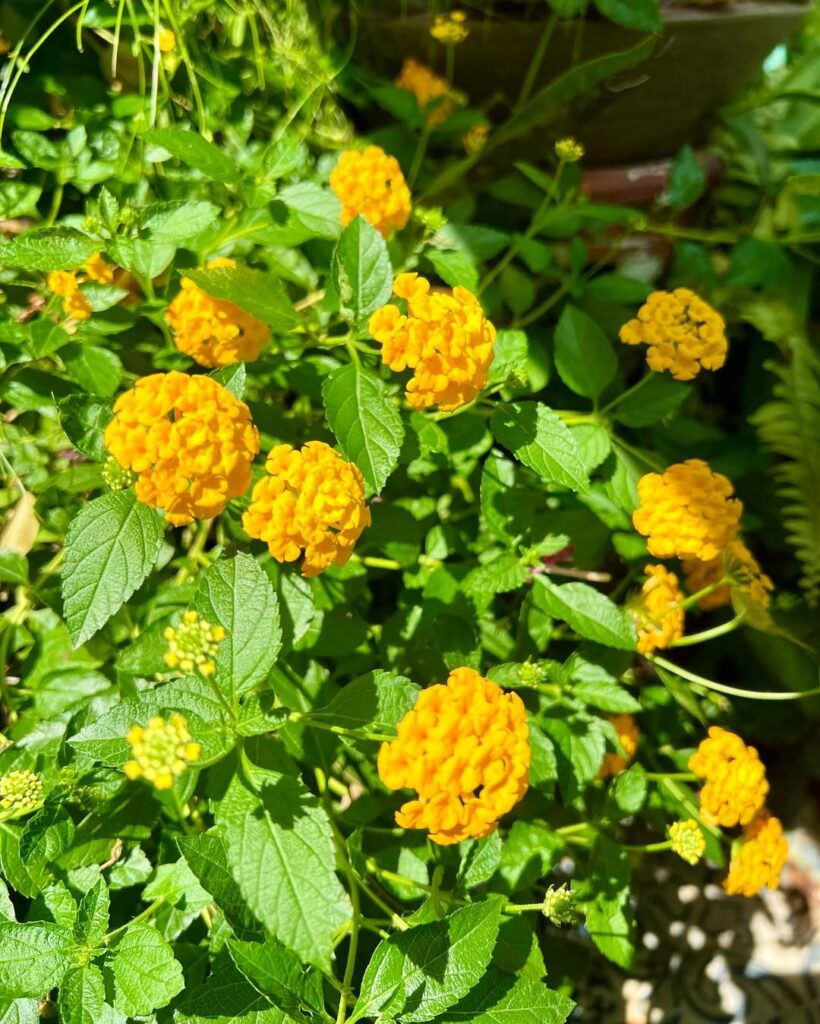
Texas Lantana is a hardy perennial flowering plant native to the American Southwest that produces clusters of small, vibrant blooms in yellow, orange, red, or multi-colored combinations. This drought-resistant plant forms a dense, spreading mound of dark green foliage and attracts butterflies and hummingbirds while being deer-resistant. Its ability to thrive in hot, dry conditions makes it an excellent choice for water-conscious gardeners.
- Light: Full sun; tolerates partial shade but blooms best in direct sunlight
- Water: Low to moderate; water deeply but infrequently once established
- Soil: Well-draining, tolerates poor soil; prefers slightly acidic to neutral pH
- Temperature: Heat tolerant; hardy in USDA zones 8-11
- Spacing: 2-3 feet apart, as plants can spread 3-6 feet wide
- Maintenance: Trim back in late winter; remove dead flowers to encourage blooming
